Petroleum Crude Oil and Hydrocarbons - Select Synthetics - AMSOIL Authorized Dealer



Main menu:
- Home Page
-
Products
-
AMSOIL Products
- Shop by Product
- Shop by Equipment
- Shop by Category
-
Product Lookup Guides
- Product Lookup Guides - Home
- Filter Lookup Guides
- Auto & Light Truck Lookup Guide
- Motorcycle & Dirt Bike Lookup Guide
- Harley-Davidson Products Guide
- All-Terrain Vehicle Lookup Guide
- Utility Terrain Vehicle Lookup Guide
- Snowmobile Lookup Guide
- Marine Outboard Lookup Guide
- Personal Watercraft Lookup Guide
- Small Engine Lookup Guide
- Free Product Catalog
- AMSOIL - The Blog
- AMSOIL YouTube Videos
- AMSOIL Performance Tests
- The AMSOIL Newsstand
- AMSOIL Testimonials
- AMSOIL Guarantee
- Safety Data Sheets
- Oil Analysis Services
- Shipping & Product Return
- Safe & Secure Shopping
-
AMSOIL Products
- About AMSOIL
-
Oil Basics
- What Is Motor Oil?
- What Is Oil Viscosity?
- What Does Motor Oil Do?
- Why Does Oil Need To Be Changed?
- How Often Should I Change My Oil?
- When Should I Do My 1st Oil Change?
- Can I Mix Different Oils?
- Lubrication Regimes
- Newtonian vs. Non-Newtonian
- Base Oil Groups
- Motor Oil Specifications
- Service Classifications & Grades
- Oil Evaluation Tests
- Oil Filtration
- What is Oil Analysis?
- Why Synthetics?
- Buy Wholesale
- FAQs
- Contact Us
Oil Basics > What Is Motor Oil?


What Is Motor Oil? – Part 1
Petroleum & Hydrocarbons
Crude Oil / Petroleum
Crude oil is the term for ‘unprocessed’ oil, the stuff that comes out of the ground. It consists of hydrocarbons of various molecular weights and other organic compounds. It is also known as petroleum. The name petroleum (literally ‘rock oil’) covers both naturally occurring unprocessed crude oil and petroleum products that are made up of refined crude oil. Petroleum is classified as a fossil fuel.
Fossil fuels are formed when large quantities of dead organisms, mostly zooplankton and algae, die and their remains settle on sea or lake beds, mixing with sediments. Vast quantities of these remains become buried under several thousand feet of silt, sand or mud, where they are subjected to intense heat and pressures under anoxic (oxygen deprived) conditions.
This process causes the organic matter to change, over long periods of time, first into a waxy material known as kerogen, which is found in various oil shales around the world, and then, with more heat and pressure, into liquid and gaseous hydrocarbons via a process known as ‘catagenesis’.
Labile kerogen breaks down to form heavy hydrocarbons (i.e. oils), refractory kerogen breaks down to form light hydrocarbons (i.e. gases), and inert kerogen forms graphite. The soluble portion of kerogen is known as bitumen (i.e. asphalt/tar).
Geologists often refer to the temperature range in which oil forms as an "oil window" – below the minimum temperature oil remains trapped in the form of kerogen, and above the maximum temperature the oil is converted to a gas through a process known as thermal cracking. Simply put, hydrocarbon cracking is the process of breaking long-chain hydrocarbons into short-chain ones.
Because most hydrocarbons are less dense than rock or water, they often migrate upward through adjacent rock layers until either reaching the surface or becoming trapped within porous rocks (known as reservoirs) by impermeable rocks above. When this happens, wells are drilled into these oil reservoirs to extract the trapped crude oil. Extracted hydrocarbons in a liquid form are often referred to as mineral oil, whereas hydrocarbons in a gaseous form are usually referred to as natural gas.
Sometimes, oil formed at extreme depths may migrate and become trapped at a much shallower level. One example of this are the Athabasca Oil Sands (also called Athabasca Tar Sands or Alberta Tar Sands) located in Alberta, Canada, which contain the world’s largest deposit of bitumen (or extra-heavy crude oil). Including the Oil Sands, Canada has the world’s second largest crude oil reserves after Saudi Arabia.
Oil Sands are reservoirs of partially biodegraded oil (bitumen) still in the process of escaping and being biodegraded, but they contain so much migrating oil that, although most of it has escaped, vast amounts are still present – more than can be found in conventional oil reservoirs. Bitumen is extracted on a commercial scale from the Athabasca Oil Sands primarily by surface mining (including open-pit mining).
Crude oil varies in color, from clear to yellow to green to brown to black, and in viscosity, from watery to almost solid, and is the raw material used for a wide variety of petrochemicals, including gasoline, kerosene, solvents, fertilizers, pesticides, adhesives, plastics, paraffin waxes, and lubricating oils.
Hydrocarbons (Hydrocarbon Molecules)
(Please note: This section on hydrocarbons does get pretty “technical” but is well worth the read as it will help you better understand the various aspects and properties of different motor oils. However, if your brain starts to hurt from all the “technical babble”, you can simply scroll down to the next section “Motor Oil”.)
Petroleum consists of a very large number of different hydrocarbon molecules of different shapes and sizes; the most commonly found molecules are alkanes (paraffins), cycloalkanes (naphthenes), aromatic hydrocarbons, or more complicated chemicals like asphaltenes. Each variety has a unique mix of molecules which define its physical and chemical properties, like color and viscosity.
A Hydrocarbon is a chemical compound, or molecule, made up of hydrogen (the simplest, lightest and most abundant chemical element in the universe and third most abundant on Earth) and carbon (a naturally abundant element that occurs in many inorganic and in all organic compounds including all living things).
Carbon atoms form more compounds than all other elements combined; several million carbon compounds are known. Each carbon atom forms a total of four bonds (four single bonds, two single and one double bond, two double bonds, or one single and one triple bond) with up to four other atoms (in the case of a hydrocarbon molecule, it bonds with either a hydrogen atom or another carbon atom).

Octane Molecule
Hydrocarbon molecules contain a lot of energy and are very versatile (able to take on many forms). They come in various lengths and structures, from straight chains to branching chains to rings (including three-dimensional structures).
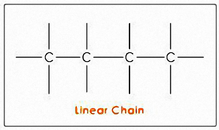
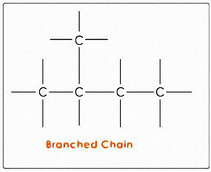
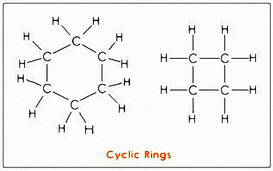
Alkanes for instance, also known as paraffins, are saturated hydrocarbons with either straight carbon chains or branched chains (called isoparaffins) that have only single bonds in the chemical structure of their molecules. They generally have from 5 to 40 carbon atoms per molecule, although trace amounts of shorter or longer molecules may be present.
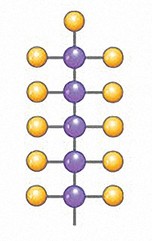

Alkane (Paraffin) Branched Alkane (Isoparaffin)
Cycloalkanes, also known as naphthenes, are saturated hydrocarbon compounds that have one or more rings of carbon atoms to which hydrogen atoms are attached. Cycloalkanes are classified into small, common, medium, and large cycloalkanes. Cycloalkanes are similar to alkanes in their general physical properties, but they have higher boiling points, melting points, and densities than alkanes.
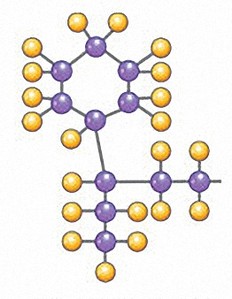
Cycloalkane (Naphthene)
Aromatic Hydrocarbons, on the other hand, are unsaturated hydrocarbons which have one or more planar six-carbon rings, called benzene rings, to which hydrogen atoms are attached. They are often drawn as cyclic alkenes (olefins), but their structure and properties are different and they are not considered to be alkenes/olefins. They tend to burn with a sooty flame, and have a sweet aroma. Some are carcinogenic.
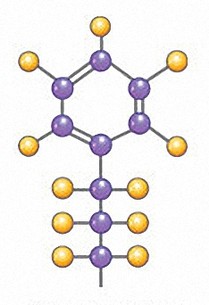
Aromatic Hydrocarbon
These different molecules are separated by fractional distillation at an oil refinery.
Motor Oil (or Engine Oil)
Engines, transmissions and other mechanical systems contain hundreds of moving parts. Though the metal surfaces of these parts look smooth, they are actually full of microscopic peaks and valleys. When the peak of one surface touches its mating surface, it causes damage and may lead to component failure. Failure prevention and wear reduction are the primary functions of lubrication.
In modern vehicle engines, the oil pump takes oil from the oil pan and sends it through the oil filter into galleries (passageways), from which the oil lubricates the main bearings holding the crankshaft up at the main journals and camshaft bearings operating the valves.

In typical engines, oil pressure-fed from the oil galleries to the main bearings enters holes in the main journals of the crankshaft. From these holes in the main journals, the oil moves through passageways inside the crankshaft to exit holes in the rod journals to lubricate the rod bearings and connecting rods.
In the past, engines relied on rapidly moving parts to splash and lubricate the contacting surfaces between the piston rings and interior surfaces of the cylinders. However, in most modern engines today, there are also passageways through the rods which carry oil from the rod bearings to the rod-piston connections and lubricate the contacting surfaces between the piston rings and interior surfaces of the cylinders. The oil then flows or drips back down into the oil pan.
Engine Lubricants create a lubricating film between surfaces of adjacent moving parts minimizing direct contact between them, decreasing heat caused by friction and reducing wear, thus protecting the engine. Coating metal surfaces with oil also keeps them from being exposed to oxygen, inhibiting oxidation at elevated operating temperatures and preventing rust or corrosion.
Motor oil also serves as a cooling agent. In some engines oil is sprayed through a nozzle inside the crankcase onto the piston to provide cooling of specific parts that undergo high temperature strain. In use, the oil transfers heat through convection as it flows through the engine, by means of air flow over the surface of the oil pan, an oil cooler, and through the buildup of oil gases evacuated by the Positive Crankcase Ventilation (PCV) system.
Motor oil is made up of two basic components: Base stock (or Base Oils) and Additives.
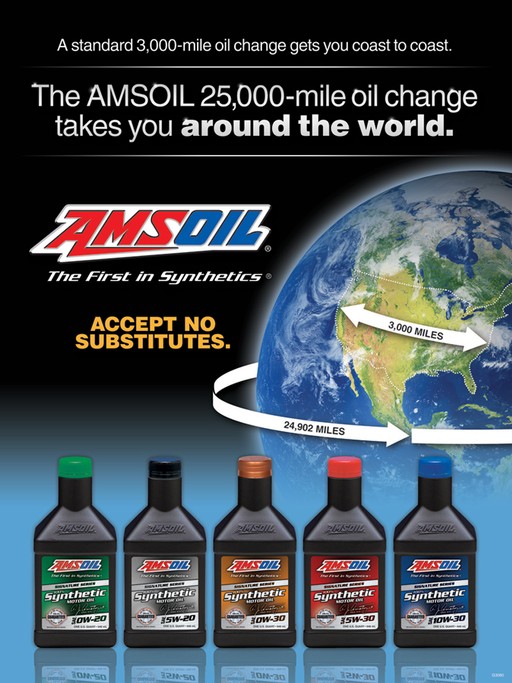

Home Page | Products | About AMSOIL | Oil Basics | Buy Wholesale | FAQs | Contact Us | General Site Map